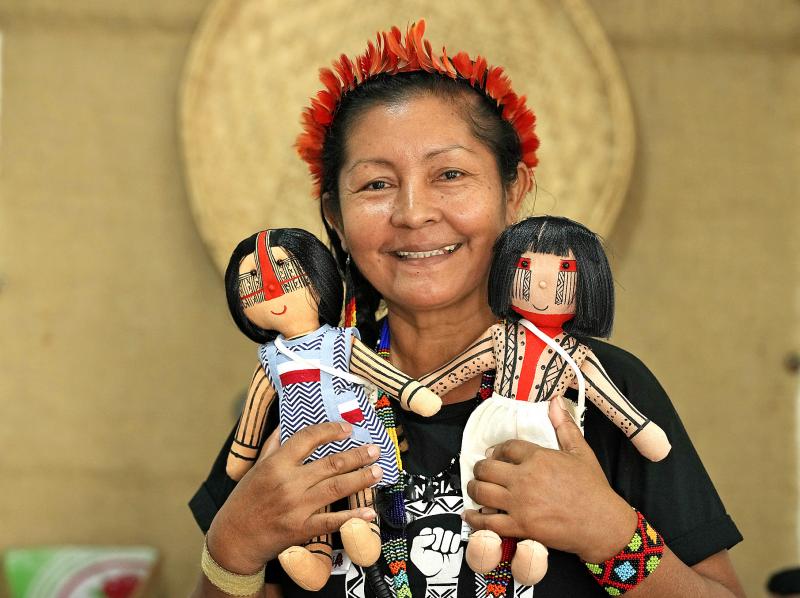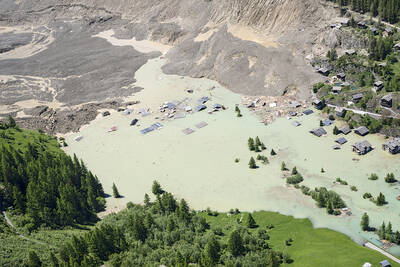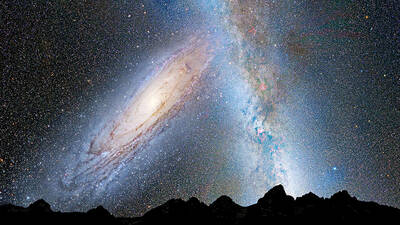Luakam Anambe wanted her newborn granddaughter to have a doll — something she had never owned as a child working in slave-like conditions in Brazil’s Amazon rainforest. However, she wanted the doll to share their indigenous features, and there was nothing like that in stores. So she sewed one herself from cloth and stuffing.
The doll had brown skin, long, dark hair, and the same face and body paint used by the Anambe. It delighted passers-by; while indigenous dolls can be found elsewhere in Latin America, they remain mostly absent in Brazil, home to nearly 900,000 people identifying as indigenous in the last census. A business idea was born, and her modest home now doubles as a workshop where she and her daughter produce dolls for a growing clientele.
“Before, only white dolls existed, then came the black ones, but indigenous ones didn’t appear,” said Anambe, 53, wearing a beaded necklace and a headdress of delicate orange feathers. “When indigenous women see the dolls, they sometimes cry.”

Photo: AP
Since 2013, Anambe has sold more than 5,000 dolls at local fairs and through social media, mailing them across the country, and she is fundraising to attend a German fair with the aim of exporting to Europe.
Her burgeoning business in Rio de Janeiro is a world removed from the Amazonian state of Para, where her life of hardship began.
She was one of 15 children and Anambe’s parents sent her and two sisters to live and work at a plantation. Just seven years old, she was charged with looking after the plantation owner’s toddler.
She remembers being rebuked after asking the owner’s wife for a doll; she should work, not play, Anambe recalls being told. And she received no compassion when telling the woman that she had been sexually abused. She never received any pay and complaints often ended with young Anambe locked in a dark tobacco storeroom, alone.
Anambe said she was 15 when the plantation owner forced her to marry his friend, a man two decades her senior, with whom she had a daughter. Anambe soon fled her violent husband, leaving her baby with family.
“We’re fighters, in a fight to survive,” she said, referring to indigenous people who regularly face peril from Amazon land grabbers, loggers, ranchers and miners.
Before colonization, “there were millions of indigenous people in Brazil. Today, there are far fewer, and every passing day, less and less,” she said.
Anambe worked for years as a cleaning lady in Belem, Para state’s capital. However, she felt life had more in store for her and that she should seek opportunities in one of Brazil’s biggest cities. She hitched an eight-day ride to Rio with a long-haul trucker and thought of him as a godsend, especially because he did not abuse her.
Her Indigenous features stood out in Rio, and she experienced prejudice. Eventually, she landed a job in a bikini factory and was able to send for her daughter, by then in her 20s. Little by little, they saved enough money to move from their one-room shack to a small home, where she started making clothes for some fashionable Rio brands. With the skills she developed sitting behind her sewing machine, she made her first doll.
“It’s like a mirror,” said her daughter, Atyna Pora, who now works with her mother. “Through the doll, we see ourselves, and we have to break down the taboo behind it, because we have always been very discriminated against.”
Anambe and Pora have expanded their portfolio to include dolls bearing face and body paints of five other indigenous groups. Each is handsewn, dressed in traditional clothes and carefully painted with a sharpened branch from a tree in their backyard, following indigenous custom.
“When I left the state of Para, I didn’t leave just for myself. I went for other women, too,” Anambe said. “Anaty came to give this empowerment to us, indigenous women.”

The collapse of the Swiss Birch glacier serves as a chilling warning of the escalating dangers faced by communities worldwide living under the shadow of fragile ice, particularly in Asia, experts said. Footage of the collapse on Wednesday showed a huge cloud of ice and rubble hurtling down the mountainside into the hamlet of Blatten. Swiss Development Cooperation disaster risk reduction adviser Ali Neumann said that while the role of climate change in the case of Blatten “still needs to be investigated,” the wider impacts were clear on the cryosphere — the part of the world covered by frozen water. “Climate change and

Poland is set to hold a presidential runoff election today between two candidates offering starkly different visions for the country’s future. The winner would succeed Polish President Andrzej Duda, a conservative who is finishing his second and final term. The outcome would determine whether Poland embraces a nationalist populist trajectory or pivots more fully toward liberal, pro-European policies. An exit poll by Ipsos would be released when polls close today at 9pm local time, with a margin of error of plus or minus 2 percentage points. Final results are expected tomorrow. Whoever wins can be expected to either help or hinder the

DENIAL: Musk said that the ‘New York Times was lying their ass off,’ after it reported he used so much drugs that he developed bladder problems Elon Musk on Saturday denied a report that he used ketamine and other drugs extensively last year on the US presidential campaign trail. The New York Times on Friday reported that the billionaire adviser to US President Donald Trump used so much ketamine, a powerful anesthetic, that he developed bladder problems. The newspaper said the world’s richest person also took ecstasy and mushrooms, and traveled with a pill box last year, adding that it was not known whether Musk also took drugs while heading the so-called US Department of Government Efficiency (DOGE) after Trump took power in January. In a

It turns out that looming collision between our Milky Way and Andromeda galaxies might not happen after all. Astronomers on Monday said that the probability of the two spiral galaxies colliding is less than previously thought, with a 50-50 chance within the next 10 billion years. That is essentially a coin flip, but still better odds than previous estimates and farther out in time. “As it stands, proclamations of the impending demise of our galaxy seem greatly exaggerated,” the Finnish-led team wrote in a study appearing in Nature Astronomy. While good news for the Milky Way galaxy, the latest forecast might be moot